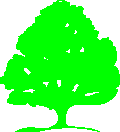
The Fungi and Slime-Moulds of Coombe Wood
This page of Fungi and Slime Moulds has two parts. The first, comprising the two tables below, is the result of two surveys done by Mary Smith of the Essex Field Club. The first was on September 19th and October 15th 2012. Mary was accompanied by Gwyn Jordan for the first survey, and by John Rostron for the second. They took the photos that accompany the entries. Essex Field Club members also did a survey in the autumn of 2013. Their results comprise the second table.
The remainder of the page is an ad hoc list of species almost all of which were recorded (and photographed if possible) by John Rostron. The identification of these should be taken as, perhaps, less reliable than those in the table above, which have largely been vetted by Mary Smith. Any reference to “me” in the tables refers to Mary.
For many of the fungi listed below, at the left-hand side, there is a small i-symbol [If you hover over this with the mouse, then an information panel about that species will appear, usually with an image. i] before or after the name. If you hover over this with the mouse, then an information panel about that species will appear, usually with an image. Note, however, that a plain i-symbol [i] is purely a space-filler in lists and does not (yet) provide a link.
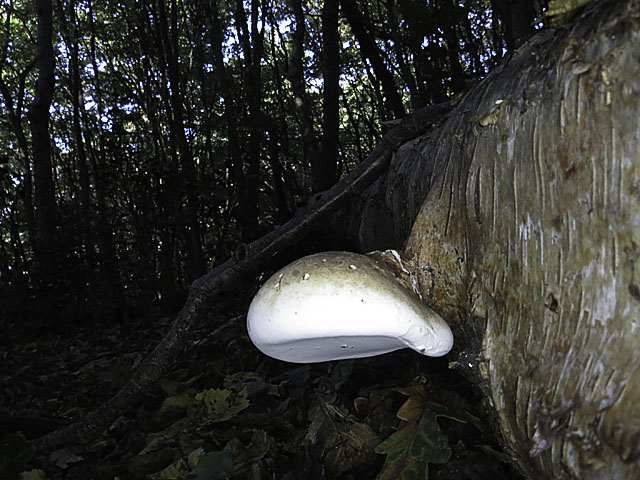
The Birch Bracket fungus is common and widespread throughout the wood.
Fungi Recorded by the Essex Field Club Surveys
I have grouped these species into five sections. First are the ordinary ‘toadstools and mushrooms’ (or Agarics), with a roughly circular cap and a stipe (stem) below. Then there are the brackets, typically growing out of trees, with an asymmetrical cap and the stipe on one side or no stipe at all. The third group are the earthballs and puffballs. The fourth group are the ‘resupinates’ – a fancy name for those that are flattened against a tree trunk or other surface. This section also includes some small growth forms without an obvious cap and stipe. The fifth and final group are the Slime Moulds or Myxomycetes, which are neither Fungi, Plants nor Animals, but from a quite distinct Kingdom of organisms. They spend most of their lives underground or in rotten wood and then, in moist conditions, they gather together and emerge to form slimy aggregations as their reproductive bodies.
The final column, headed VG, refers to which part of the wood in which that species was found. VG1 is the Village Green area designated in 2007 (south and east of the stream), and VG2 that part designated in 2013 (north and west of the stream).
Survey of Autumn 2012
| Scientific name | Common name | Comment | Location | The Agarics (‘Mushrooms and Toadstools’) |
|---|---|---|---|---|
| [i] | Agaricus silvaticus | Wood Mushroom | A good size, and good to eat | VG2 |
| [i] | Armillaria gallica | Bulbous Honey Fungus | Bulbous stipe | VG1 |
[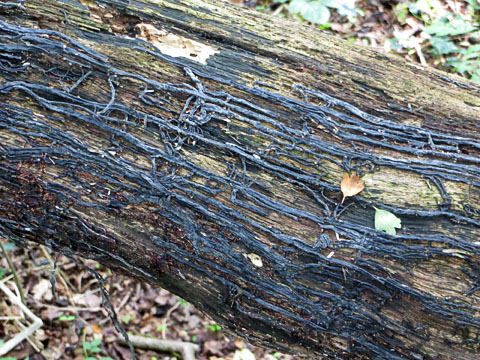 i] |
Armillaria sp | Honey Fungus | Black rhizoids in dead tree, but no fruit bodies seen so cannot name sp. | VG1 |
| [i] | Calocybe constricta (aka Tricholom(ell)a leucocephalus) | none | Totally white agaric, fairly stout, with rooting base, often twisted, in soil. The twisted bit usually stays in the soil! | VG2 |
| [i] | Chlorophyllum (aka Macrolepiota) rhacodes | Shaggy Parasol | Plain white stipe, but reddens if bruised, Parasol top. | VG1, VG2 |
| [i] | Clitocybe fragrans | Fragrant Funnel | Pale washed out colours, gills very decurrent, slight fruity scent | VG2 |
[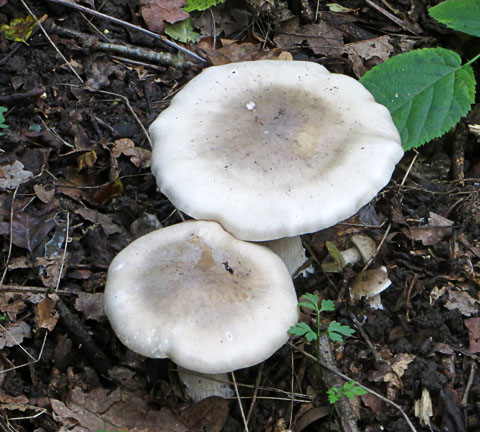 i] |
Clitocybe nebularis | Clouded Agaric | VG1, VG2 | |
[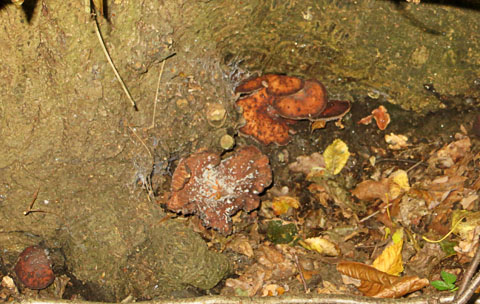 i] |
Collybia (aka Gymnopus) dryophila | Russet Toughshank | VG1, VG2 | |
[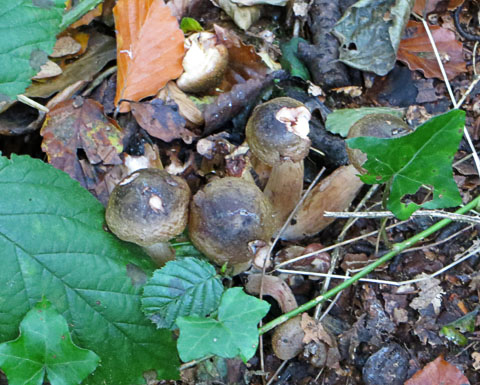 i] |
Collybia (aka Rhodocollybia) fusipes | Spindle Toughshank | Dark red-brown caps and very swollen fusiform stipes, tufted | VG1 |
| [i] | Collybia (aka Rhodocollybia) butyracea | Butter Cap | VG2 | |
[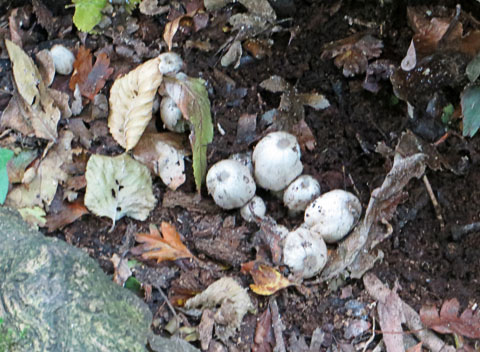 i] |
Coprinus atramentarius | Common Inkcap | VG2 | |
[ i] |
Crepidotus cesatii | none | Like C. variabilis but with spherical spores | VG2 |
[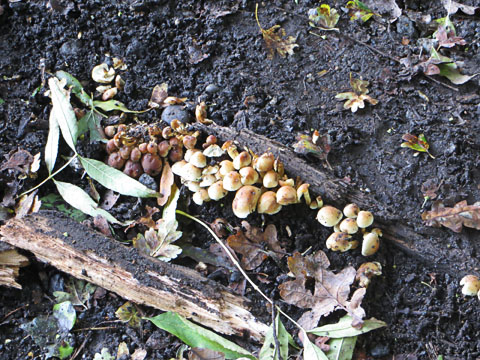 i] |
Hypholoma fasciculare | Sulphur Tuft | VG1 | |
| [i] | Inocybe geophylla | White Fibrecap | Elfin cap, pure white, with a tiny point at the tip. Spermatic smell. Very poisonous | VG1 |
| [i] | Lactarius sp | A Milkcap | Too tiny to identify sp since no spores yet. | VG1 |
[ i] |
Lactarius subdulcis | Mild Milkcap | In mosses, on S bank of stream | VG1 |
| [i] | Lepiota pseudolilacea | none | Small agaric, with black-dotted cap | VG2 |
[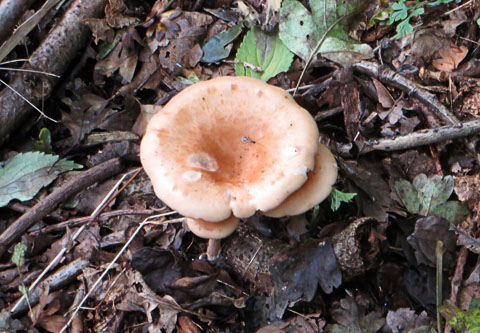 i] |
Lepista flaccida (aka L. inversa) | Tawny Funnel | Spherical spores. | VG1, VG2 |
[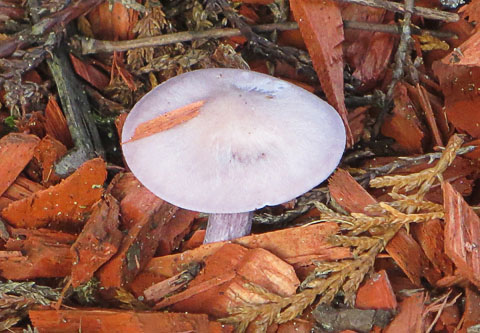 i] |
Lepista nuda | Wood Blewit | VG1 | |
[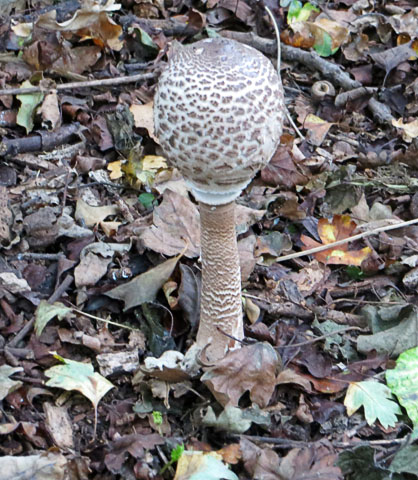 i] |
Macrolepiota procera | Parasol | ‘Snake-skin’ mottles on stipe. | VG1, VG2 |
| [i] | Mycena flavescens | none | Pale creamy cap, fantastic cystidia | VG2 |
[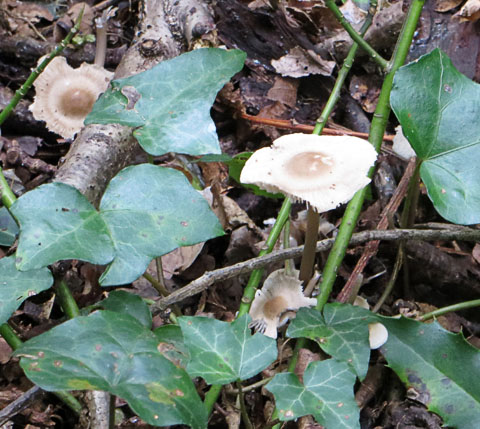 i] |
Mycena galericulata | Common Bonnet | Gills slightly pink with cross-gill ridges, and stipe can be twisted 360° and springs back when released. | VG2 |
[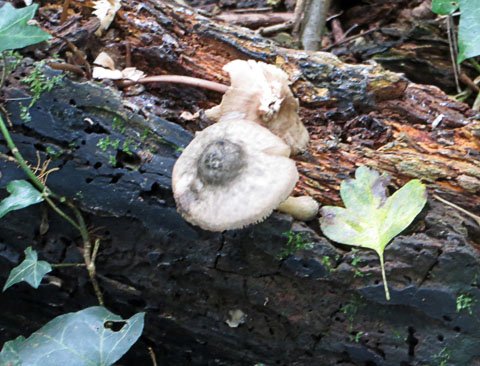 i] |
Mycena inclinata | Clustered Bonnet | On stumps, unpleasant rancid smell. | VG1, VG2 |
[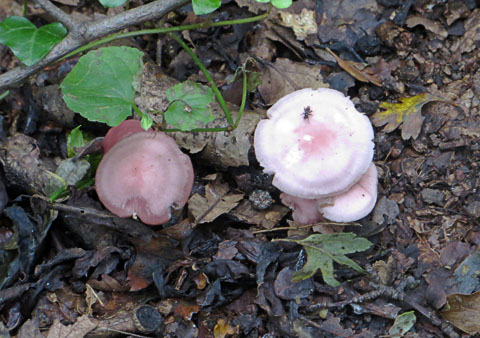 i] |
Mycena pura | Lilac Bonnet | May be shades of purple-red, rosy pink, lilac, violet. Smell of radish | VG1, VG2 |
| [i] | Mycena vitilis | Snapping Bonnet | Audible snap. Grey cap and stipe. | VG1, VG2 |
| [i] | Pleurotus cornucopiae | Branching Oyster | Layers of gilled shell-shaped fungus, pale cream, on dead or dying wood. | VG1 |
| [i] | Pluteus cervinus | Deer Shield | Brown cap, on rotten wood | VG2 |
| [i] | Pluteus salicinus | Willow Shield | Grey cap, on rotten wood | VG2 |
| [i] | Psathyrella corrugis (aka P. gracilis) | Red-edge Brittlestem | Conical hygrophanous cap, thin brittle stipe, brown/black gills when mature. On old wood or leaf litter. | VG1 | The Brackets |
| [i] | Inonotus hispidus | Shaggy Bracket | Large, usually on Ash, often high up | VG1 |
[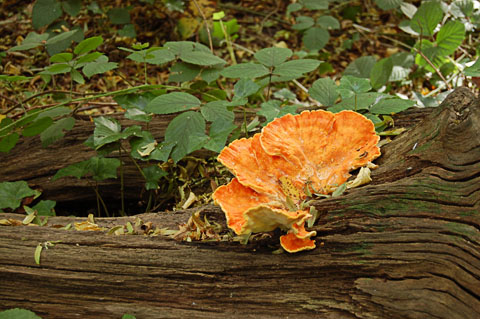 i] |
Laetiporus sulphureus | Chicken of the Woods | One large yellow blobby bracket on one tree, and another seen later with bright orange top. Often on a living tree, but killing it. | VG1 |
| [i] | Piptoporus betulinus | Birch Polypore | VG1 | |
| [i] | Polyporus durus | Bay Polypore | Bay or Chestnut brown | VG2 |
[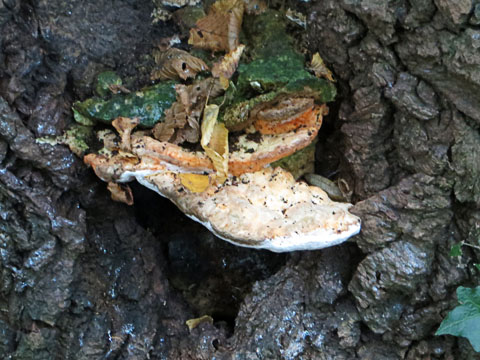 i] |
Rigidoporus ulmarius | none | Large white bracket low down in a tree, with bright orange/red tubes. | VG1 |
| [i] | Skeletocutis nivea | Hazel Bracket | Usually brown on top but always white below. Soft white bracket or knobbly growth on dead wood with tiny pores (hardly visible without a 10x lens) and very tiny spores. | VG1, VG2 |
[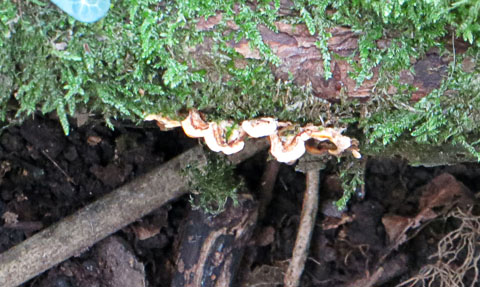 i] |
Stereum hirsutum | Common (or Hairy) Curtain Crust | Small thin brackets on dead wood, usually browns on top and light orange smooth surface below. | VG1, VG2 |
[ i] |
Trametes gibbosa | Lumpy Bracket | On Birch, not its most common host. Quite large pores, large area of attachment to host wood. | VG1 | The Puffballs and Earthballs |
[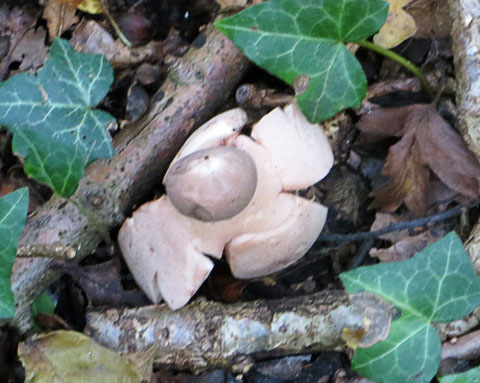 i] |
Geastrum triplex | Collared Earthstar | Large, with pale colours. The commonest of the Genus. | VG2 |
[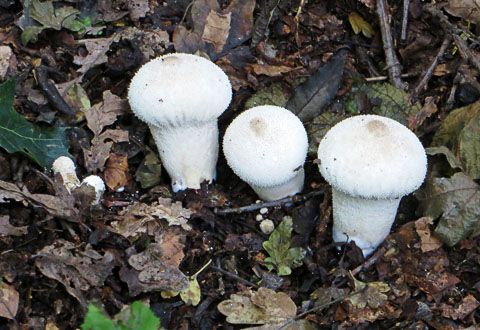 i] |
Lycoperdon perlatum | Common Puffball | VG1, VG2 | |
[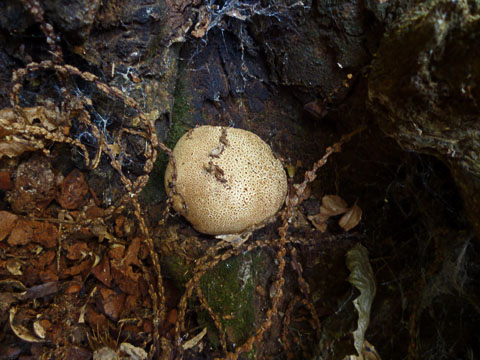 i] |
Scleroderma citrinum | Common Earthball | Firm globular pale yellow-brown ‘skin’ is brown-blackish inside due to purple-black spores. On soil, under trees. | VG1 | The Resupinates and other growth forms |
| [i] | Ascobolus lignatilis | none | Tiny yellow-brown cups on moist rotting wood. | VG1 |
| [i] | Basidioradulum radula (aka Hyphoderma) | Toothed Crust | Resupinate, starts almost flat, creamy to ochre, soon with teeth up to 4mm high. | VG2 |
[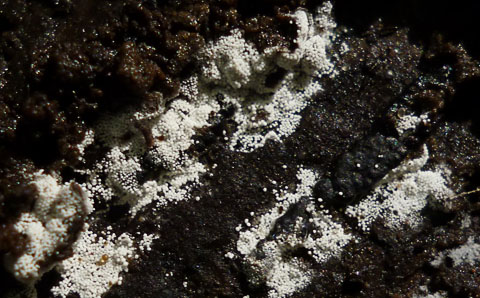 i] |
Bulbillomyces farinosus | A slime mould | On underside of rotten wood partly in water, numerous white balls. | VG1, VG2 |
[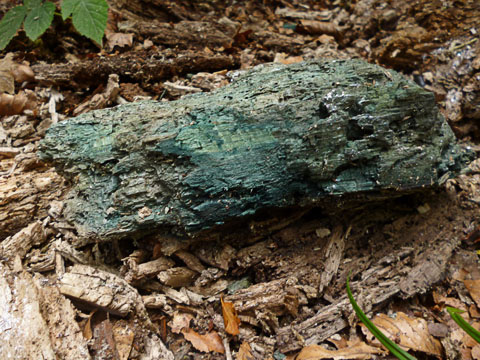 i] |
Chlorociboria aeruginascens | Green Elfcup | Makes wood blue-green, green cups not often seen. | VG1 |
| [i] | Clavulina coralloides (aka C. cristata) | Crested Coral | Tiny white branching thing on S bank of stream | VG1 |
| [i] | Cylindrobasidium laeve (aka C. evolvens) | none | Resupinate, pale, white edges. Spores pointed pear-shape. | VG2 |
[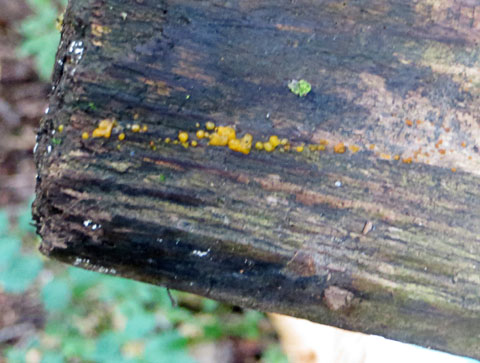 i] |
Dacrymyces stillatus | Common Jellyspot | Tiny (2mm) but clumped, orange jelly blobs on very rotten wood | VG2 |
[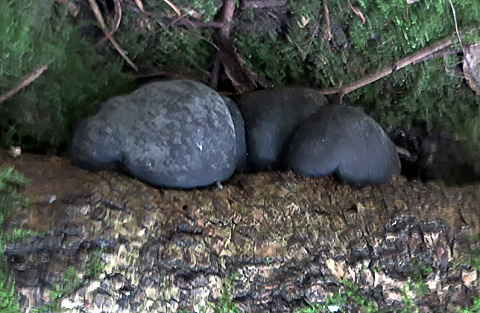 i] |
Daldinia concentrica | Cramp Balls or King Alfred’s Cakes | Pyrenomycete, Asco. Brown to black almost globose hard fruit bodies, with concentric rings inside (annual rings), coke-like texture, only on dead Ash. | VG1, VG2 |
| [i] | Diatrype stigma | Common Tarcrust | Pyrenomycete, Asco. A flat black crust with tiny papillae, mostly on Beech, Hawthorn and Cherry | VG2 |
| [i] | Diatrypella favacea (aka D.verrucaeformis) | none | Pyrenomycete, Asco. Black spots or‘pustules’ bursting through the bark, usually on dead twigs of Alder, Hazel or Beech. | VG1, VG2 |
| [i] | Diatrypella quercina | none | Pyrenomycete, Asco. Black spots bursting through the bark, usually on Oak, also can be on Willows | VG2 | [i] | Hypoxylon (aka Biscognauxia) nummularium | Beech Tarcrust | A black crust on dead Beech wood, with minute knobs, white inside. | VG1 |
| [i] | Hypoxylon (aka Nemania) serpens | none | Thick black crust with rounded papillate surface on dead wood. | VG1 |
| [i] | Lyomyces sambuci | Elder Whitewash | Resupinate of thin texture and a floury surface, very white. | VG2 |
| [i] | Mollisia cinerea | Common Grey Disco | Tiny (<1mm), watery grey cups with paler margins, on dead wood. Asco | VG1, VG2 |
| [i] | Orbilia xanthostigma | Common Glasscup | Tiny thin amber semi-transparent discs on rotten wood. | VG1 |
| [i] | Peniphorella praetermissa (aka Hyphoderma) | none | Resupinate, white, with long narrow spores and two kinds of cystidia | VG2 |
| [i] | Phellinus ferruginosus | Rusty Porecrust | Rusty brown, resupinate, tiny pores | VG2 |
| [i] | Schizopora paradoxa | Split Porecrust | Pale to deep cream resupinate with very wiggly, jagged or irregular tubes/pores, on dead wood. | VG1, VG2 |
| [i] | Xylaria hypoxylon | Candlesnuff Fungus | Tiny twig-like growths on old wood, with white tops, floury with white spores. | VG1 | The Slime Moulds |
[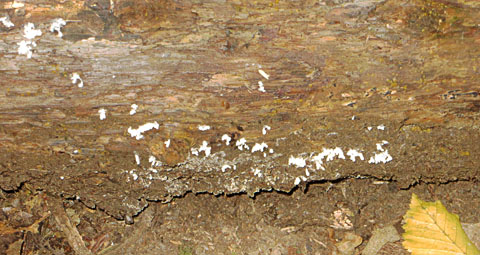 i] |
Trichia varia | A slime mould | Tiny white spheres on wood | VG1, VG2 |
[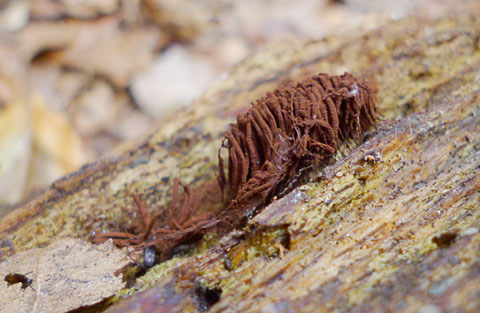 i] |
Stemonitis fuscus | (Brown rug, or Brown carpet) | A Myxomycete, up to 1cm tall, very common on dead logs or stumps. | VG1 |
Survey of Autumn 2013
| Scientific name | Common name | Comment | Location | The Agarics (‘Mushrooms and Toadstools’) |
|---|---|---|---|---|
| [i] | Agaricus impudicus | No common name, even though this species is quite common in broad-leaved woodland. The scaly cap is a good indicator | VG1 | |
[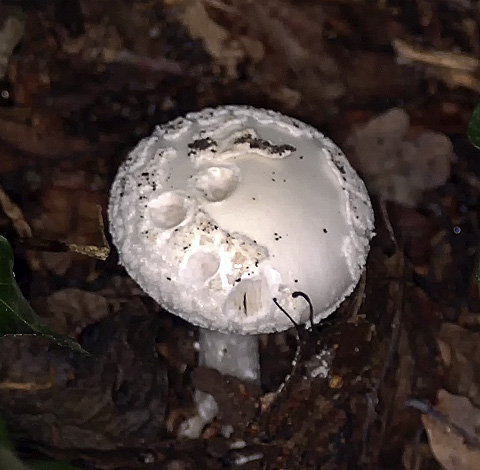 i] |
Amanita citrina var alba | False Deathcap | White all over with scales on cap, smell of new potatoes | VG1 |
[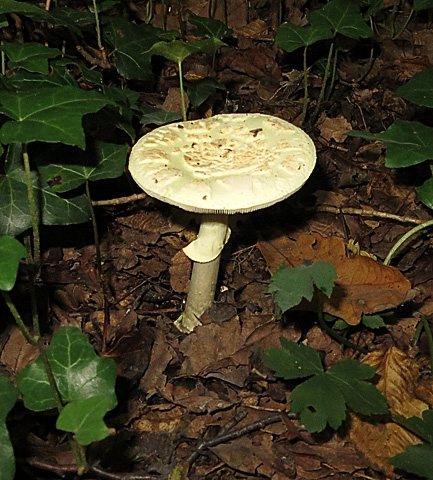 i] |
Amanita citrina var citrina | False Deathcap | As above, but with yellow tones | VG1 |
[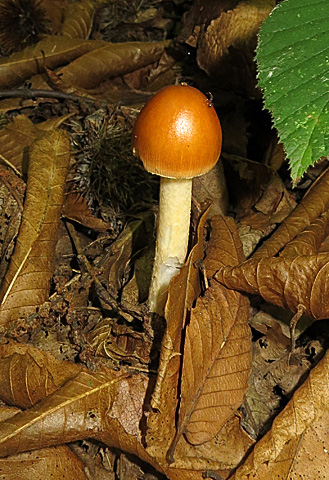 i] |
Amanita fulva | Tawny Grisette | Brown cap with white gills and stipe, with a big white bag below. | VG1 |
| [i] | Amanita rubescens | The Blusher | Mainly white, with scales on cap and large ring, but bruising pink/red when handled or chewed. | VG1 |
| [i] | Armillaria gallica | Bulbous Honey Fungus | Like the standard one, mellea , but with markedly bulbous base. Equally common, but slightly less damaging to trees | VG1 |
[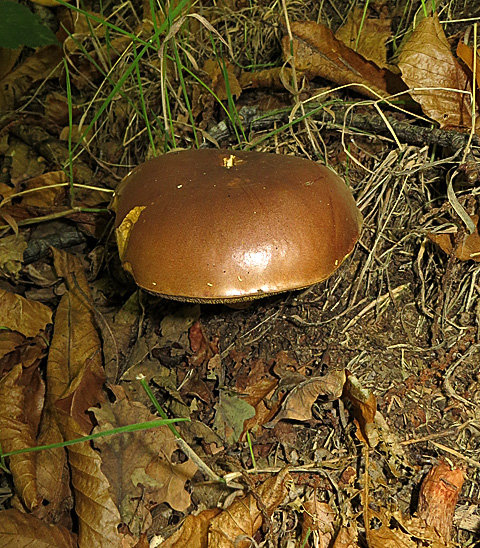 i] |
Boletus badius | Xerocomus, Bay Bolete | Bay brown cap with dull ochre tubes which bruise dark blue | VG1 |
[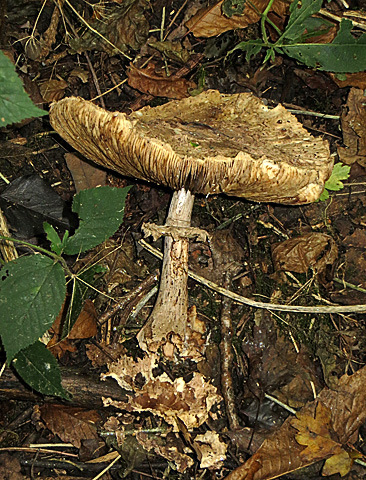 i] |
Chlorophyllum rhacodes | Macrolepiota, Shaggy Parasol | Large fungus with white all over except for the shaggy brown scales on the top of the cap. | VG1 |
| [i] | Clitocybe candicans | A small mushroom with a shiny white cap that looks like icing. White slightly decurrent gills below, and white stipe. | VG2 | |
| [i] | Clitocybe metachroa | Fawn or beige mushroom with a hint of grey all over, very much a funnel shape with a short stipe | VG2 | |
[ i] |
Clitocybe nebularis | Clouded Funnel | A stout, rather large mushroom with very firm flesh and a grey or brownish tinge on the cap, all the rest being white, usually in troops or fairy rings | VG2 |
[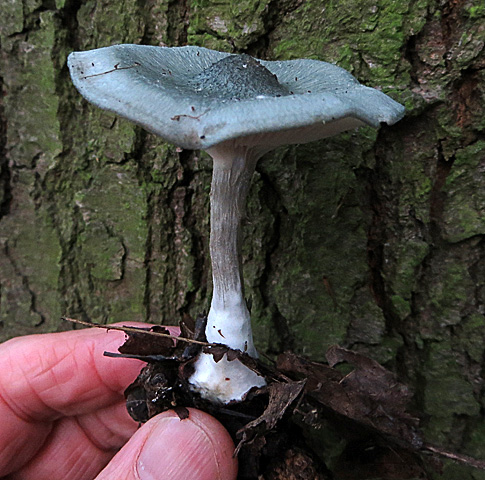 i] |
Clitocybe odora | Aniseed Funnel | Small funnel with blue-green cap and strong aniseed scent. | VG1 |
| [i] | Coprinellus micaceus | Coprinus, Glistening Inkcap | Golden domed cap with tiny crystals on the top, usually tufted. | VG1 |
[ i] |
Coprinus picaceus | Magpie Inkcap | Near bridle path access to A13 | VG1 |
| [i] | Crepidotus mollis | Peeling Oysterling | Tiny soft white squidgy cap with no stipe, pale brown gills below, on dead twigs. | VG1 |
| [i] | Gymnopus butyracea | Collybia, Butter Cap | Greasy feel to its brown cap, white gills below and pale brown stipe. | VG1 |
| [i] | Gymnopus dryophila | Collybia, Russet Toughshank | Russet cap with white gills and russet stipe | VG1 |
| [i] | Gymnopus maculata | Collybia, Spotted Toughshank | All white, but as it ages, or gets bruised, it goes slowly pink then rusty colour. | VG1, VG2 |
| [i] | Hebeloma crustuliniforme | Poison Pie | Cap often slightly slimy, pale tan/ochre, gills the colour of milky coffee and smell of radish | VG1 |
[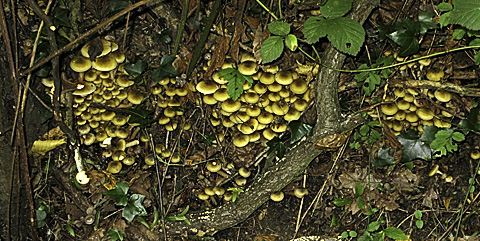 i] |
Sulphur Tuft | Orange cap with yellow edges, young gills bright sulphur yellow but soon turning grey-green then black, yellow stipe, always tufted | VG1 | |
| [i] | Inocybe geophylla var lilacina | Lilac Fibrecap | Lilac cap with cigar-colour gills and a spermatic smell. | VG1 |
| [i] | Inocybe geophylla | White Fibrecap | See above in VG1, but this has the usual white cap, not lilac | VG2 |
[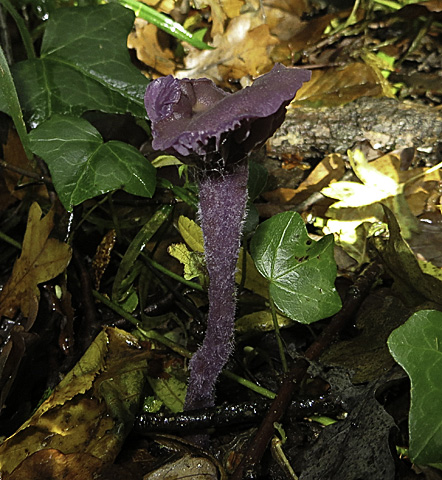 i] |
Laccaria amethystina | Amethyst Deceiver | Deep violet all over, small but usually in troops | VG1 |
| [i] | Laccaria laccata | The Deceiver | Usually orange or tan on cap, but pink gills widely spaced below, small but often in troops | VG1 |
[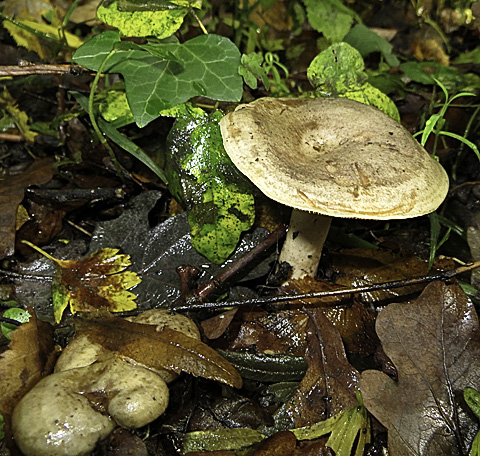 i] |
Lactarius blennius | Beech Milkcap | Grey cap with mottles in rings, dull cream gills, oozing milk when damaged. Often with Beech | VG1 |
| [i] | Lactarius quietus | Oakbug Milkcap | Red-brown cap and stipe, gills paler, oozing milk when damaged. Smell described as Bed Bugs(!), or oily | VG1 |
| [i] | Lepiota cristata | Stinking Dapperling | A small mushroom with pinkish-brown scales all over the cap making circular patterns, the rest all white. It has an unpleasant smell. | VG2 |
[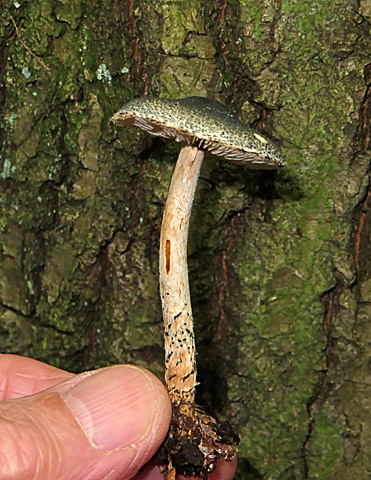 i] |
Lepiota grangei | Small mushroom with dark green scales on conical cap and white gills below, but stipe red near base. New to me (Mary Smith), very uncommon. | VG1, VG2 | |
| [i] | Lepista flaccida | L. inversa, Tawny Funnel | Orange colour cap, gills paler and very decurrent, with short short stipe | VG1 |
| [i] | Leucoagaricus serenus | Widely conical cap almost creamy-white but turning yellowish with age. Gills and stipe white but faint ring falls off soon. New to me. | VG1 | |
[ i] |
Macrolepiota procera | Parasol | Large mushroom, often dinner-plate size flat cap, with brown scales. Gills white, stipe pale but with large floppy ring and snake-skin type markings below ring. | VG1 |
| [i] | Mycena arcangeliana | Angel's Bonnet | Pale olive green tinge to cap and stipe, gills paler, on dead wood | VG1 |
[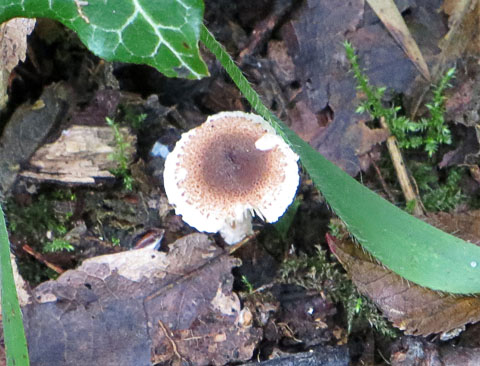 i] |
Mycena galericulata | Common Bonnet | Conical light brown cap, gills white but with faint pink tinge and lots of low interconnecting pieces between them. On dead wood | VG1, VG2 |
[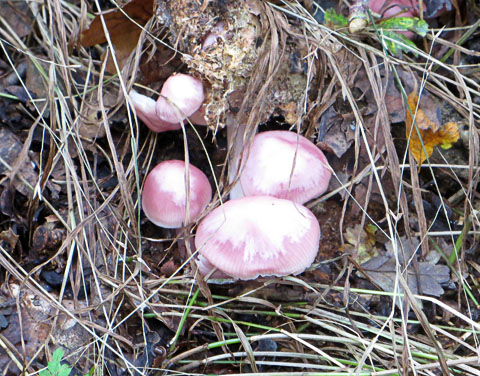 i] |
Mycena pura | Lilac Bonnet | Lovely mauve to pink flat cap, gills and stipe paler, smell of radish | VG1 |
| [i] | Mycena smithiana | A tiny white Bonnet with few widely-spaced gills in troops on dead Oak leaves. Rather uncommon, or much overlooked, new to me | NW | |
| [i] | Mycena vitilis | Snapping Bonnet | Grey-brown cap with long pale grey stipe, which snaps audibly. On dead wood | VG1 |
[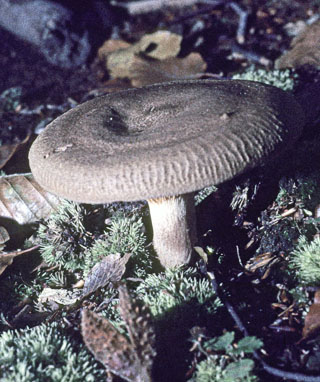 i] |
Paxillus involutus | Brown Rollrim | Deep brown cap starts rounded then becomes flat and finally funnel shaped, with edge always hairy and rolled under. Brown gills, decurrent and brown stipe | VG1 |
| [i] | Pluteus chrysophaeus | Yellow Shield | Not the rare leoninus ! Bright yellow-orange cap, pink gills below, on dead wood | NW |
| [i] | Psathyrella conopilus | Conical Brittlestem | Dark brown bell-shaped cap with almost black gills below, and a paler brown stipe. Not unlike P . corrugis in VG1, but larger. | VG2 |
| [i] | Psathyrella corrugis | P. gracilis, Red Edge Brittlestem | Conical or bell-shaped cap, all over deep brown, gills with narrow red edge (lens), a slender, delicate mushroom. | VG1 |
[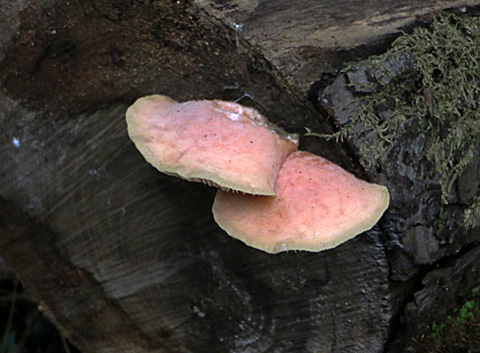 i] |
Rhodotus palmatus | The Peach | Rubbery pink mushroom only on dead Elm | VG1 |
[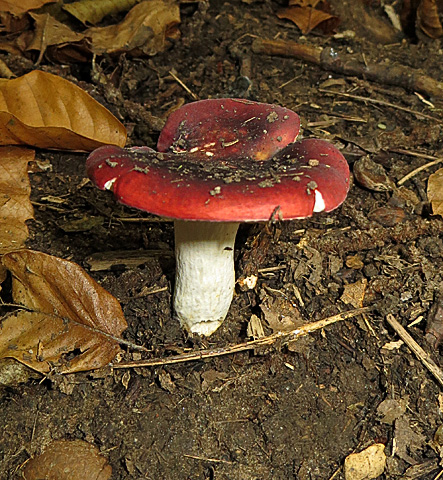 i] |
Russula atropurpurea | Purple Brittlegill | Deep red-purple cap, whitish gills and stipe, usually with Oak | VG1 |
[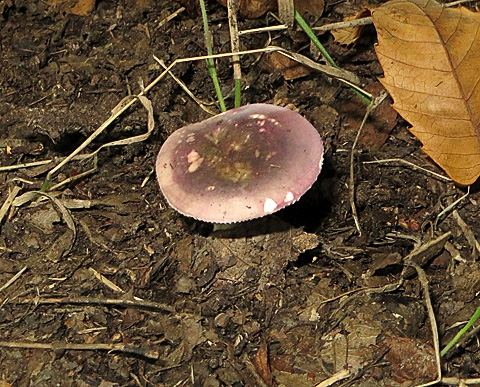 i] |
Russula cyanoxantha | Charcoal Burner | Cap can be almost any colour, but usually light purple with tinges of green, pure white gills and stipe. Often with Oak | VG1 |
[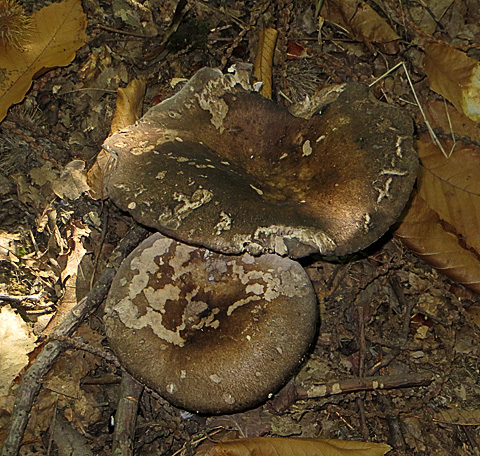 i] |
Russula nigricans | Blackening Brittlegill | Large mushroom whitish all over but soon turning red then quickly black s it ages or when bruised. Gills are very widely spaced. Usually with Beech or Oak | VG1 |
[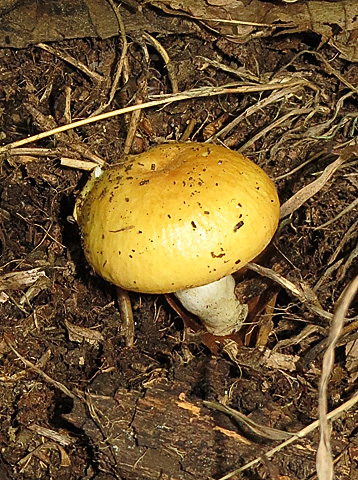 i] |
Russula ochroleuca | Ochre Brittlegill | Ochre cap with almost white gills and stipe; grows with any tree. | VG1 |
[ i] |
Tricholoma sulphureum | Sulphur Knight | Bright sulphur-yellow all over, with terrible smell like coal gas or tar. Often with Oak | VG1 |
[ i] |
Xerula radicata | Rooting Shank | A pale ochre-brown cap, often slightly wrinkled, and a l-o-n-g white stipe going into the soil. | NW | The Brackets |
| [i] | Auricularia auriculo-judea | Jelly Ear | Brown rubbery growths somewhat ear-shaped or cup-shaped it troops on dead Elder | NW |
| [i] | Bjerkandera adusta | Smoky Bracket | Various brownish tones on top, but with a white edge, which is continued below, but most of the pore area is a mid grey. Usually, but by no means always, on dead Beech | VG2 |
| [i] | Calocera cornea | Small Stagshorn | Small yellow teeth on dead wood, often in lines where the twig is rotting | NW |
[ i] |
Daldinia concentrica | Cramp Balls / King Alfred’s Cakes | Asco, with black coke-like blobs on dead Ash wood | VG1 |
| [i] | Polyporus squamosus | Dryad’s Saddle | A fairly large Polypore type of bracket, usually saddle-shaped, with a yellow-brown cap, spotted with brown scales, paler tube layer below and short stipe. Grows where the tree has been wounded. | NW |
| [i] | Postia caesia | Conifer Blueing Bracket | Small white bracket with small pores, blue on top but usually white below, on dead conifer wood only | VG1 |
| [i] | Postia subcaesia | Blueing Bracket | Small white bracket with small pores on a variety of hardwoods, often no blueing seen. | VG1 |
| [i] | Stereum gausapatum | Bleeding Oak Crust | Crusty frilly bracket on dead Oak wood, mainly golden-brown, which 'bleeds' when cut eg with a fingernail | VG1 |
[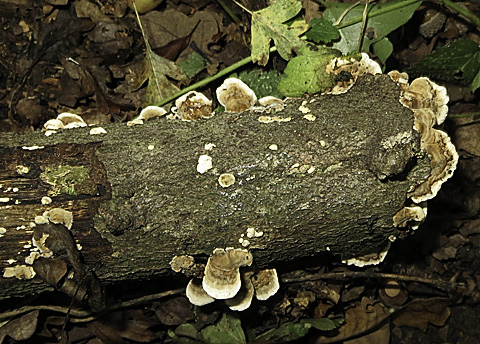 i] |
Stereum hirsutum | Hairy Curtain Crust | Crusty frilly bracket on dead wood, mainly dull brown and hairy on top but orange fertile surface beneath | VG1 |
| [i] | Trametes versicolor | Coriolus, Turkeytail | Crusty bracket on dead wood with multi-zoned cap of varying colours, and white pores below | VG1, VG2 | The Puffballs and Earthballs |
[ i] |
Lycoperdon perlatum | Common Puffball | A sphere on a fat stalk with tiny soft 'spines' all over, largest on the top. All white until mature, when it becomes brown inside with spores. Often in troops. | VG2 |
| [i] | Scleroderma bovista | Potato Earthball | Like other Earthballs in having a scaly skin over a small ball, with loads of spores inside. Here the scales are very tiny, and the clean skin is much more obvious, looking rather like a potato. | NW |
[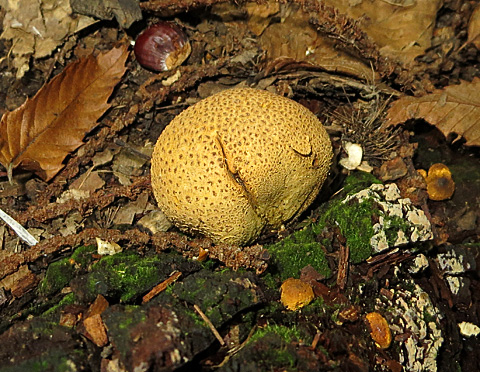 i] |
Scleroderma verrucosum | Scaly Earthball | Round brown lump with scaly skin and thin wall surrounding the mass of dark spores, and a big 'root' below. | VG1 |
| [i] | Basidioradulum radula | Hyphoderma | A crust rather like Radulomyces molaris, but a paler brown-beige, and with fewer, blunter, obvious teeth. | VG2, NW |
| [i] | Bisporella citrina | Lemon Disco | Asco. Tiny bright lemon yellow spots on dead wood | VG1 |
| [i] | Ceriporia reticulata | A thin soft crust on dead wood, the crust having tiny pores looking like a network (lens), with no flesh behind it. New to me | VG1 | |
| [i] | Clavulina cinerea | Grey Coral | Tufted fruit-body looking like small Coral, light grey all over | VG1 |
| [i] | Clavulina coralloides | C. cristata, Crested Coral | As above, but almost white, with fringed tips to the branches | VG1 |
| [i] | Dacrymyces stillatus | Common Jellyspot | Dull yellow jelly spots on dead wood | VG1 |
| [i] | Diatrype stigma | Common Tarcrust | Asco, black crust with tiny pinpoint bumps, on dead wood | VG1 |
| [i] | Exidia thuretiana | White Brain | Translucent whitish jelly blobs, often crowded together, on dead sticks | VG2 |
| [i] | Hyphodontia sambuci | Lyomyces, Elder Whitewash | Looks like white matt paint on a twig, usually, but not always, on Elder. | VG1 |
| [i] | Hypocrea argillacea | Asco. Blobs of yellow jelly with distinct deeper yellow bits inside, more or less regularly arranged equidistant over the surface. New to me | NW | |
| [i] | Hypomyces chrysospermus | Bolete Eater | Asco, like a mould, starts white but goes bright yellow, on old Boletes, completely covering them. | VG1 |
| [i] | Lasiosphaeria ovinus | Asco, tiny (0.5mm) white woolly balls on dead wood | VG1 | |
| [i] | Mycoacia uda | Cream to yellow crust on wood, fertile surface with teeth (hand lens) closely spaced all over. | VG1 | |
| [i] | Nectria cinnabarina | Coral Spot | Asco, bright pink blobs on dead twigs, very common | VG1 |
| [i] | Nectria episphaeria | Asco, scattered tiny red blobs on Tarcrusts such as Diatrype stigma | VG1 | |
[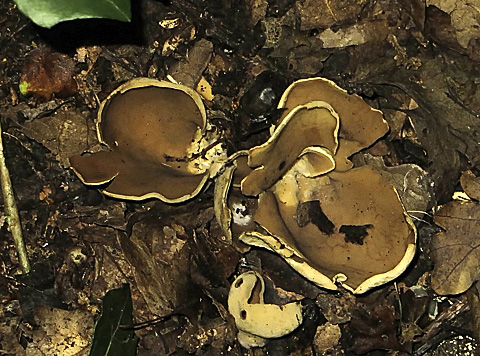 i] |
Otidea alutacea | Tan Ear | Asco, golden soft 'ears' or shell-like shapes, often clustered, on soil | VG1 |
[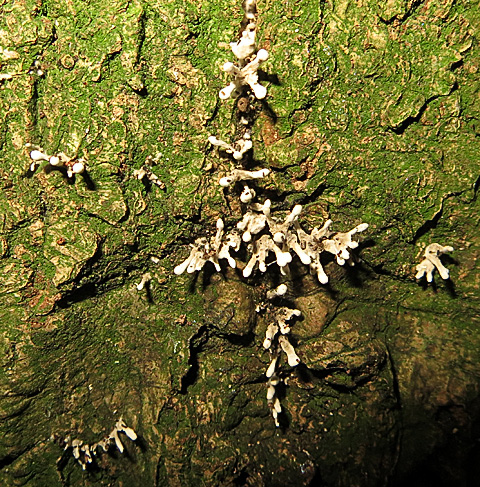 i] |
Phleogena faginea | Curry Fungus | Tiny white blobs on bark of Oak, strong smell of curry, very uncommon, more usually on Beech | VG2 |
| [i] | Radulomyces molaris | Rusty brown crust with conspicuous teeth, very irregular, on dead wood, usually Oak. | VG1 | |
| [i] | Schizopora paradoxa | Split Porecrust | A crust on dead wood which starts white then goes creamy-yellow as it ages. Pores all over surface usually have jagged or split edges | VG1 |
[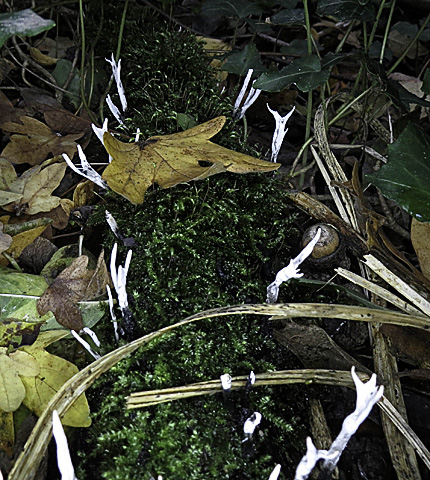 i] |
Xylaria hypoxylon | Candlesnuff Fungus | Asco, tiny 'twigs' on dead wood, black at base and white powder (spores) covering the upper part. | VG1 | The Slime Moulds |
[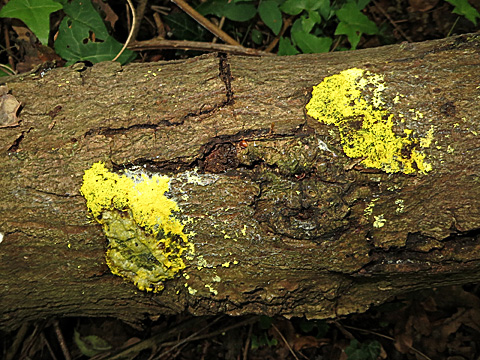 i] |
Fuligo septica | Flowers of Tan | Myxomycete. Bright yellow low heap of powder growing on dead wood | VG2 |
Other records of Fungi
There has not been any systematic fungus survey of Coombe Wood before the autumn of 2012. The following list is mostly based on the casual observation of John Rostron.
Agarics (Mushrooms and Toadfstools)
- [
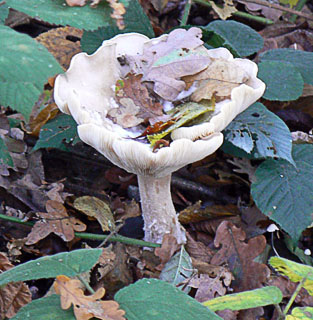 The Clouded Agaric is probably the commonest large
fungus, and is found throughout the wood, often as rings.
i] Clouded Agaric, (Clitocybe nebulosa),
The Clouded Agaric is probably the commonest large
fungus, and is found throughout the wood, often as rings.
i] Clouded Agaric, (Clitocybe nebulosa), - [The Common Funnel-Cap is smaller than the Clouded Agaric, and has a light tan appearance. It occurs scattered throughout the wood. i] Common Funnel-Cap (Clitocybe infundibliformis),
- [i] Deceiver (Laccaria laccaria),
- [
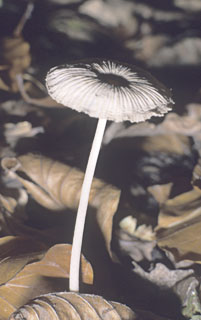 This image is rather over-exposed, and the violet
colouration of this toadstool is washed out. It is quite common in the
northern plateau. Despite the virulent colour, it is quite edible.
i] Amethyst Deceiver (Laccaria amethystina),
This image is rather over-exposed, and the violet
colouration of this toadstool is washed out. It is quite common in the
northern plateau. Despite the virulent colour, it is quite edible.
i] Amethyst Deceiver (Laccaria amethystina), - [
 This poisonous toadstool also occurs mainly in the
plateau area. i] Brown Rollrim
(Paxillus involutus),
This poisonous toadstool also occurs mainly in the
plateau area. i] Brown Rollrim
(Paxillus involutus), - [The Yellow-stainer is sometimes the second most common large fungus. It mainly occurs in the south of the wood around Coombe Kop. i] Yellow-staining Mushroom (Agaricus xanthodermus),
- [
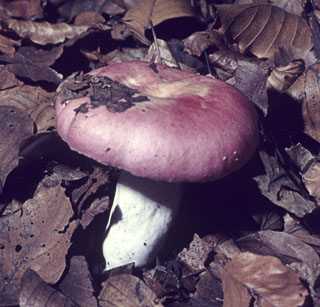 The Beechwood Sickener’s virulent colouration
warns of its poisonous properties. It occurs in the Hornbeam coppice between
the main stream and the pond. i] Beechwood Sickener
(Russula mairei),
The Beechwood Sickener’s virulent colouration
warns of its poisonous properties. It occurs in the Hornbeam coppice between
the main stream and the pond. i] Beechwood Sickener
(Russula mairei), - [
 The Charcoal Burner occurs in the Hornbeam coppice
between the main stream and the pond. i]
Charcoal Burner (Russula cyanoxantha),
The Charcoal Burner occurs in the Hornbeam coppice
between the main stream and the pond. i]
Charcoal Burner (Russula cyanoxantha), - [The Common Yellow Russula is a medium-small mushroom fairly common in the Hornbeam coppice. i] Common Yellow Russula (Russula ochroleuca),
- [
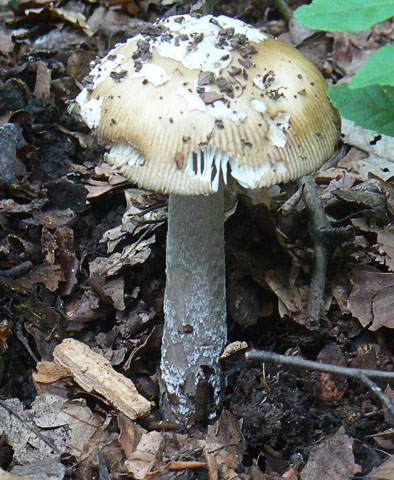 We think that this is a Blusher but are not certain.
It could be one ofthe other species of Amantia. The photo was taken at the end
of June 2012.i] Blusher (possibly) (Amantia rubescens),
We think that this is a Blusher but are not certain.
It could be one ofthe other species of Amantia. The photo was taken at the end
of June 2012.i] Blusher (possibly) (Amantia rubescens), - [
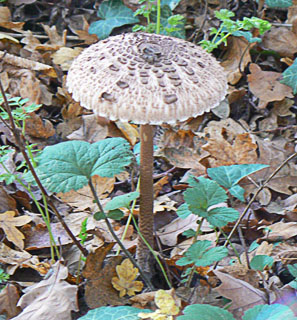 The Parasol can grow up to 20cm tall (about eight
inches) with a cap 10cm across. It occurs around the main Coombewood
Ride (between Coombewood Drive and the London Road).
i] Parasol Mushroom (Lepiota procera),
The Parasol can grow up to 20cm tall (about eight
inches) with a cap 10cm across. It occurs around the main Coombewood
Ride (between Coombewood Drive and the London Road).
i] Parasol Mushroom (Lepiota procera), - [Wood Blewits is a medium-sized mushroom fairly common between the London Road and the stream from the pond. i] Wood Blewits (Lepista nuda),
- [
 Velvet Shank is unusual in that it can occur
throughout the autumn, winter and into the spring. This photo was taken by
Richard Russell on December 19th 2009.i]
Velvet Shank (Flammulina velutipes),
Velvet Shank is unusual in that it can occur
throughout the autumn, winter and into the spring. This photo was taken by
Richard Russell on December 19th 2009.i]
Velvet Shank (Flammulina velutipes), - [
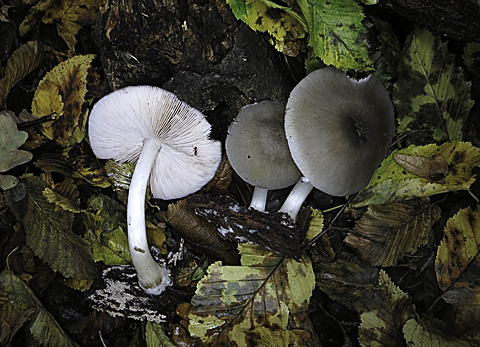 This was growing on a fallen log near the pond in
October 2013.i]
Porcelain Fungus (Oudemansiella_mucida),
This was growing on a fallen log near the pond in
October 2013.i]
Porcelain Fungus (Oudemansiella_mucida), - [
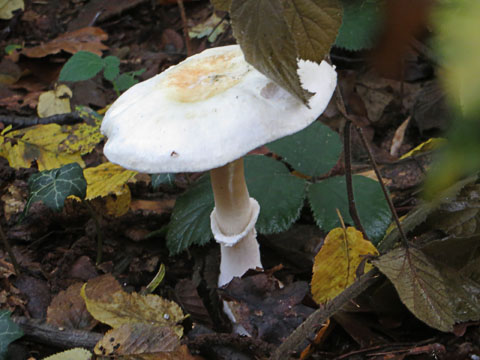
i] False Death Cap (Amantia citrina), - [
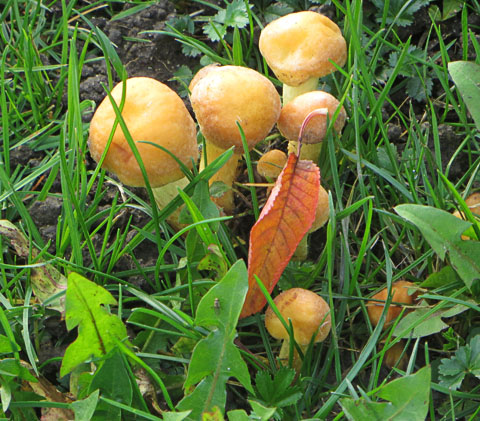
This had sulphur-yellow cap, gills and stipe.i] Sulphur Knight (Tricholoma sulphureum).
Bracket Fungi
- [
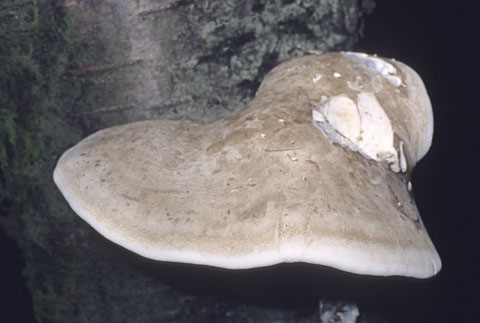 Birch Bracket Fungus grows on dead and dying birch
trees throughout the wood. i]
Birch Bracket Fungus (Pitopterus betulinus),
Birch Bracket Fungus grows on dead and dying birch
trees throughout the wood. i]
Birch Bracket Fungus (Pitopterus betulinus), - [
 The Oyster Mushroom grows on decaying wood. The ones in this
image are growing on a fallen log.i]
Oyster Mushroom (Pleurotus ostreatus),
The Oyster Mushroom grows on decaying wood. The ones in this
image are growing on a fallen log.i]
Oyster Mushroom (Pleurotus ostreatus),
Other Fungi
- [
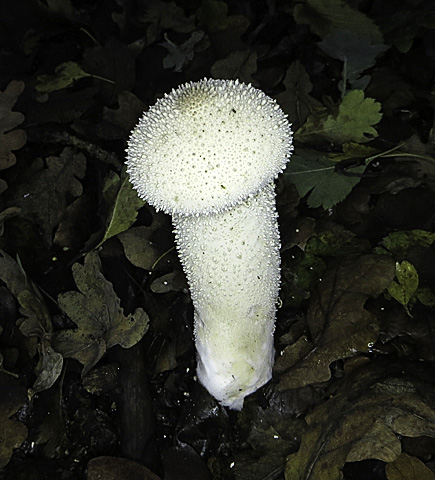 Lycoperdon excipuliforme is mainly found near the stream.
i] Lycoperdon excipuliforme, a stalked puffball,
Lycoperdon excipuliforme is mainly found near the stream.
i] Lycoperdon excipuliforme, a stalked puffball, - [
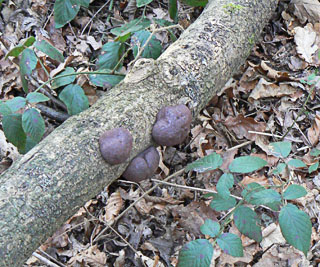 King Alfred’s Cakes grow on fallen timber
scattered throughout the wood and look like blackened golf balls.
i] King Alfred’s Cakes (Daldina concentrica),
King Alfred’s Cakes grow on fallen timber
scattered throughout the wood and look like blackened golf balls.
i] King Alfred’s Cakes (Daldina concentrica), - [
 Candlesnuff Fungus grows on mossy, fallen timber
scattered throughout the wood and resembles a burnt-out, ashen candle wick.
i] Candlesnuff Fungus (Xylaria hypoxylon).
Candlesnuff Fungus grows on mossy, fallen timber
scattered throughout the wood and resembles a burnt-out, ashen candle wick.
i] Candlesnuff Fungus (Xylaria hypoxylon).
Slime-Fungi
- [
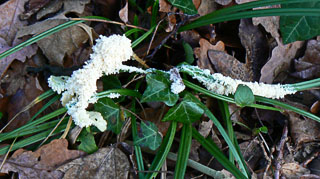 This one was near the main stream in February.
i] Slime-Fungus, possibly Mucilago crustacea.
This one was near the main stream in February.
i] Slime-Fungus, possibly Mucilago crustacea. - [
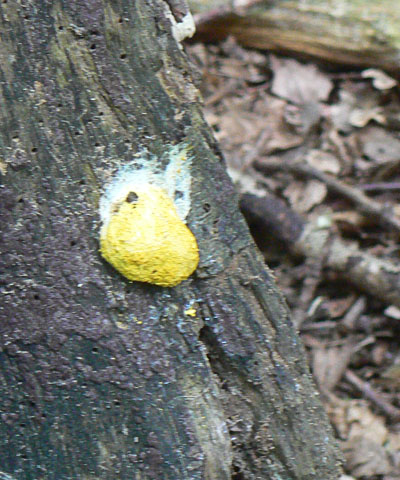 This one was near the pond in June. This
slime-mould is also known as “Flowers of Tan”
or “Dog’s Vomit”! i]
Slime-Fungus, Fuligo septica.
This one was near the pond in June. This
slime-mould is also known as “Flowers of Tan”
or “Dog’s Vomit”! i]
Slime-Fungus, Fuligo septica. - [
 Taken in October 2013. i]
Slime-Fungus, Lycogala terrestre.
Taken in October 2013. i]
Slime-Fungus, Lycogala terrestre.
